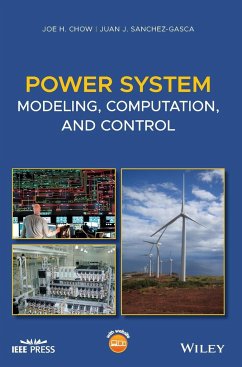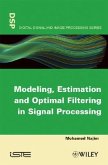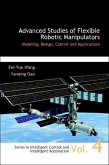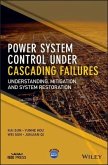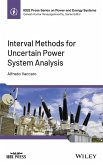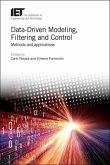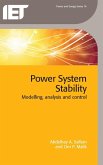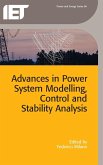- Gebundenes Buch
- Merkliste
- Auf die Merkliste
- Bewerten Bewerten
- Teilen
- Produkt teilen
- Produkterinnerung
- Produkterinnerung
PROVIDES STUDENTS WITH AN UNDERSTANDING OF THE MODELING AND PRACTICE IN POWER SYSTEM STABILITY ANALYSIS AND CONTROL DESIGN, AS WELL AS THE COMPUTATIONAL TOOLS USED BY COMMERCIAL VENDORS Bringing together wind, FACTS, HVDC, and several other modern elements, this book gives readers everything they need to know about power systems. It makes learning complex power system concepts, models, and dynamics simpler and more efficient while providing modern viewpoints of power system analysis. Power System Modeling, Computation, and Control provides students with a new and detailed analysis of voltage…mehr
Andere Kunden interessierten sich auch für
![Modeling, Estimation and Optimal Filtering in Signal Processing Modeling, Estimation and Optimal Filtering in Signal Processing]() Mohamed NajimModeling, Estimation and Optimal Filtering in Signal Processing292,99 €
Mohamed NajimModeling, Estimation and Optimal Filtering in Signal Processing292,99 €![Advanced Studies of Flexible Robotic Manipulators: Modeling, Design, Control and Applications Advanced Studies of Flexible Robotic Manipulators: Modeling, Design, Control and Applications]() Advanced Studies of Flexible Robotic Manipulators: Modeling, Design, Control and Applications198,99 €
Advanced Studies of Flexible Robotic Manipulators: Modeling, Design, Control and Applications198,99 €![Power System Control Under Cascading Failures Power System Control Under Cascading Failures]() Kai SunPower System Control Under Cascading Failures172,99 €
Kai SunPower System Control Under Cascading Failures172,99 €![Interval Methods for Uncertain Power System Analysis Interval Methods for Uncertain Power System Analysis]() Alfredo VaccaroInterval Methods for Uncertain Power System Analysis134,99 €
Alfredo VaccaroInterval Methods for Uncertain Power System Analysis134,99 €![Data-Driven Modeling, Filtering and Control Data-Driven Modeling, Filtering and Control]() Data-Driven Modeling, Filtering and Control157,99 €
Data-Driven Modeling, Filtering and Control157,99 €![Power System Stability: Modelling, Analysis and Control Power System Stability: Modelling, Analysis and Control]() Abdelhay A. SallamPower System Stability: Modelling, Analysis and Control194,99 €
Abdelhay A. SallamPower System Stability: Modelling, Analysis and Control194,99 €![Advances in Power System Modelling, Control and Stability Analysis Advances in Power System Modelling, Control and Stability Analysis]() Advances in Power System Modelling, Control and Stability Analysis189,99 €
Advances in Power System Modelling, Control and Stability Analysis189,99 €-
-
-
PROVIDES STUDENTS WITH AN UNDERSTANDING OF THE MODELING AND PRACTICE IN POWER SYSTEM STABILITY ANALYSIS AND CONTROL DESIGN, AS WELL AS THE COMPUTATIONAL TOOLS USED BY COMMERCIAL VENDORS Bringing together wind, FACTS, HVDC, and several other modern elements, this book gives readers everything they need to know about power systems. It makes learning complex power system concepts, models, and dynamics simpler and more efficient while providing modern viewpoints of power system analysis. Power System Modeling, Computation, and Control provides students with a new and detailed analysis of voltage stability; a simple example illustrating the BCU method of transient stability analysis; and one of only a few derivations of the transient synchronous machine model. It offers a discussion on reactive power consumption of induction motors during start-up to illustrate the low-voltage phenomenon observed in urban load centers. Damping controller designs using power system stabilizer, HVDC systems, static var compensator, and thyristor-controlled series compensation are also examined. In addition, there are chapters covering flexible AC transmission systems (FACTS)--including both thyristor and voltage-sourced converter technology--and wind turbine generation and modeling. * Simplifies the learning of complex power system concepts, models, and dynamics * Provides chapters on power flow solution, voltage stability, simulation methods, transient stability, small signal stability, synchronous machine models (steady-state and dynamic models), excitation systems, and power system stabilizer design * Includes advanced analysis of voltage stability, voltage recovery during motor starts, FACTS and their operation, damping control design using various control equipment, wind turbine models, and control * Contains numerous examples, tables, figures of block diagrams, MATLAB plots, and problems involving real systems * Written by experienced educators whose previous books and papers are used extensively by the international scientific community Power System Modeling, Computation, and Control is an ideal textbook for graduate students of the subject, as well as for power system engineers and control design professionals.
Hinweis: Dieser Artikel kann nur an eine deutsche Lieferadresse ausgeliefert werden.
Hinweis: Dieser Artikel kann nur an eine deutsche Lieferadresse ausgeliefert werden.
Produktdetails
- Produktdetails
- Verlag: Wiley
- Seitenzahl: 608
- Erscheinungstermin: 21. Januar 2020
- Englisch
- Abmessung: 250mm x 175mm x 40mm
- Gewicht: 1309g
- ISBN-13: 9781119546870
- ISBN-10: 1119546877
- Artikelnr.: 58123477
- Herstellerkennzeichnung
- Libri GmbH
- Europaallee 1
- 36244 Bad Hersfeld
- 06621 890
- Verlag: Wiley
- Seitenzahl: 608
- Erscheinungstermin: 21. Januar 2020
- Englisch
- Abmessung: 250mm x 175mm x 40mm
- Gewicht: 1309g
- ISBN-13: 9781119546870
- ISBN-10: 1119546877
- Artikelnr.: 58123477
- Herstellerkennzeichnung
- Libri GmbH
- Europaallee 1
- 36244 Bad Hersfeld
- 06621 890
JOE H. CHOW (¿¿¿), PHD, FIEEE, NAE, is Institute Professor of Electrical, Computer, and Systems Engineering at Rensselaer Polytechnic Institute, Troy, NY, USA. JUAN J. SANCHEZ-GASCA, PHD, FIEEE, is a Technical Director at GE Energy Consulting, Schenectady, NY, USA.
Preface xvii About the Companion Website xxi 1 Introduction 1 1.1 Electrification 1 1.2 Generation, Transmission, and Distribution Systems 2 1.2.1 Central Generating Station Model 2 1.2.2 Renewable Generation 4 1.2.3 Smart Grids 5 1.3 Time Scales 5 1.3.1 Dynamic Phenomena 5 1.3.2 Measurements and Data 5 1.3.3 Control Functions and System Operation 7 1.4 Organization of the Book 7 Part I System Concepts 9 2 Steady-State Power Flow 11 2.1 Introduction 11 2.2 Power Network Elements and Admittance Matrix 12 2.2.1 Transmission Lines 12 2.2.2 Transformers 13 2.2.3 Per Unit Representation 14 2.2.4 Building the Network Admittance Matrix 14 2.3 Active and Reactive Power Flow Calculations 16 2.4 Power Flow Formulation 19 2.5 Newton-Raphson Method 21 2.5.1 General Procedure 21 2.5.2 NR Solution of Power Flow Equations 22 2.6 Advanced Power Flow Features 27 2.6.1 Load Bus Voltage Regulation 27 2.6.2 Multi-area Power Flow 28 2.6.3 Active Line Power Flow Regulation 29 2.6.4 Dishonest Newton-Raphson Method 30 2.6.5 Fast Decoupled Loadflow 30 2.6.6 DC Power Flow 31 2.7 Summary and Notes 31 Appendix 2.A Two-winding Transformer Model 32 Appendix 2.B LU Decomposition and Sparsity Methods 36 Appendix 2.C Power Flow and Dynamic Data for the 2-area, 4-machine System 39 Problems 42 3 Steady-State Voltage Stability Analysis 47 3.1 Introduction 47 3.2 Voltage Collapse Incidents 48 3.2.1 Tokyo, Japan: July 23, 1987 48 3.2.2 US Western Power System: July 2, 1996 48 3.3 Reactive Power Consumption on Transmission Lines 49 3.4 Voltage Stability Analysis of a Radial Load System 55 3.4.1 Maximum Power Transfer 59 3.5 Voltage Stability Analysis of Large Power Systems 61 3.6 Continuation Power Flow Method 64 3.6.1 Continuation Power Flow Algorithm 66 3.7 An AQ-Bus Method for Solving Power Flow 67 3.7.1 Analytical Framework for the AQ-Bus Method 69 3.7.2 AQ-Bus Formulation for Constant-Power-Factor Loads 70 3.7.3 AQ-Bus Algorithm for Computing Voltage Stability Margins 71 3.8 Power System Components Affecting Voltage Stability 73 3.8.1 Shunt Reactive Power Supply 74 3.8.2 Under-Load Tap Changer 76 3.9 Hierarchical Voltage Control 79 3.10 Voltage Stability Margins and Indices 80 3.10.1 Voltage Stability Margins 80 3.10.2 Voltage Sensitivities 81 3.10.3 Singular Values and Eigenvalues of the Power Flow Jacobian Matrix 82 3.11 Summary and Notes 82 Problems 83 4 Power System Dynamics and Simulation 87 4.1 Introduction 87 4.2 Electromechanical Model of Synchronous Machines 88 4.3 Single-Machine Infinite-Bus System 90 4.4 Power System Disturbances 94 4.4.1 Fault-On Analysis 94 4.4.2 Post-Fault Analysis 96 4.4.3 Other Types of Faults 98 4.5 Simulation Methods 98 4.5.1 Modified Euler Methods 99 4.5.1.1 Euler Full-Step Modification Method 100 4.5.1.2 Euler Half-Step Modification Method 101 4.5.2 Adams-Bashforth Second-Order Method 101 4.5.3 Selecting Integration Stepsize 102 4.5.4 Implicit Integration Methods 104 4.5.4.1 Integration of DAEs 105 4.6 Dynamic Models of Multi-Machine Power Systems 106 4.6.1 Constant-Impedance Loads 107 4.6.2 Generator Current Injections 108 4.6.3 Network Equation Extended to the Machine Internal Node 108 4.6.4 Reduced Admittance Matrix Approach 109 4.6.5 Method for Dynamic Simulation 109 4.7 Multi-Machine Power System Stability 114 4.7.1 Reference Frames for Machine Angles 115 4.8 Power System Toolbox 117 4.9 Summary and Notes 119 Problems 119 5 Direct Transient Stability Analysis 123 5.1 Introduction 123 5.2 Equal-Area Analysis of a Single-Machine Infinite-Bus System 124 5.2.1 Power-Angle Curve 124 5.2.2 Fault-On and Post-Fault Analysis 126 5.3 Transient Energy Functions 127 5.3.1 Lyapunov Functions 128 5.3.2 Energy Function for Single-Machine Infinite-Bus Electromechanical Model 128 5.4 Energy Function Analysis of a Disturbance Event 131 5.5 Single-Machine Infinite-Bus Model Phase Portrait and Region of Stability 135 5.6 Direct Stability Analysis using Energy Functions 138 5.7 Energy Functions for Multi-Machine Power Systems 139 5.7.1 Direct Stability Analysis for Multi-Machine Systems 142 5.7.2 Computation of Critical Energy 143 5.8 Dynamic Security Assessment 146 5.9 Summary and Notes 146 Problems 147 6 Linear Analysis and Small-Signal Stability 149 6.1 Introduction 149 6.2 Electromechanical Modes 150 6.3 Linearization 151 6.3.1 State-Space Models 151 6.3.2 Input-Output Models 152 6.3.3 Modal Analysis and Time-Domain Solutions 152 6.3.4 Time Response of Linear Systems 154 6.3.5 Participation Factors 156 6.4 Linearized Models of Single-Machine Infinite-Bus Systems 157 6.5 Linearized Models of Multi-Machine Systems 160 6.5.1 Synchronizing Torque Matrix and Eigenvalue Properties 162 6.5.2 Modeshapes and Participation Factors 162 6.6 Developing Linearized Models of Large Power Systems 164 6.6.1 Analytical Partial Derivatives 165 6.6.2 Numerical Linearization 169 6.7 Summary and Notes 171 Problems 171 Part II Synchronous Machine Models and their Control Systems 175 7 Steady-State Models and Operation of Synchronous Machines 177 7.1 Introduction 177 7.2 Physical Description 177 7.2.1 Amortisseur Bars 179 7.3 Synchronous Machine Model 179 7.3.1 Flux Linkage and Voltage Equations 181 7.3.2 Stator (Armature) Self and Mutual Inductances 183 7.3.3 Mutual Inductances between Stator and Rotor 183 7.3.4 Rotor Self and Mutual Inductances 184 7.4 Park Transformation 185 7.4.1 Electrical Power in dq0 Variables 188 7.5 Reciprocal, Equal Lad Per-Unit System 189 7.5.1 Stator Base Values 189 7.5.2 Stator Voltage Equations 190 7.5.3 Rotor Base Values 191 7.5.4 Rotor Voltage Equations 191 7.5.5 Stator Flux-Linkage Equations 192 7.5.6 Rotor Flux-Linkage Equations 192 7.5.7 Equal Mutual Inductance 192 7.6 Equivalent Circuits 196 7.6.1 Flux-Linkage Circuits 196 7.6.2 Voltage Equivalent Circuits 197 7.7 Steady-State Analysis 199 7.7.1 Open-Circuit Condition 199 7.7.2 Loaded Condition 201 7.7.3 Drawing Voltage-Current Phasor Diagrams 202 7.8 Saturation Effects 204 7.8.1 Representations of Magnetic Saturation 205 7.9 Generator Capability Curves 207 7.10 Summary and Notes 209 Problems 209 8 Dynamic Models of Synchronous Machines 213 8.1 Introduction 213 8.2 Machine Dynamic Response During Fault 213 8.2.1 DC Offset and Stator Transients 215 8.3 Transient and Subtransient Reactances and Time Constants 216 8.4 Subtransient Synchronous Machine Model 221 8.5 Other Synchronous Machine Models 227 8.5.1 Flux-Decay Model 227 8.5.2 Classical Model 228 8.6 dq-axes Rotation Between a Generator and the System 229 8.7 Power System Simulation using Detailed Machine Models 230 8.7.1 Power System Simulation Algorithm 231 8.8 Linearized Models 232 8.9 Summary and Notes 234 Problems 235 9 Excitation Systems 237 9.1 Introduction 237 9.2 Excitation System Models 238 9.3 Type DC Exciters 239 9.3.1 Separately Excited DC exciter 239 9.3.2 Self-Excited DC Exciter 243 9.3.3 Voltage Regulator 244 9.3.4 Initialization of DC Type Exciters 245 9.3.5 Transfer Function Analysis 246 9.3.6 Generator and Exciter Closed-Loop System 248 9.3.7 Excitation System Response Ratios 251 9.4 Type AC Exciters 252 9.5 Type ST Excitation Systems 254 9.6 Load Compensation Control 257 9.7 Protective Functions 259 9.8 Summary and Notes 259 Appendix 9.A Anti-Windup Limits 260 Problems 261 10 Power System Stabilizers 265 10.1 Introduction 265 10.2 Single-Machine Infinite-Bus System Model 266 10.3 Synchronizing and Damping Torques 271 10.3.1
Te2 Under Constant Field Voltage 272 10.3.2
Te2 With Excitation System Control 273 10.4 Power System Stabilizer Design using Rotor Speed Signal 275 10.4.1 PSS Design Requirements 276 10.4.2 PSS Control Blocks 277 10.4.3 PSS Design Methods 279 10.4.4 Torsional Filters 284 10.4.5 PSS Field Tuning 287 10.4.6 Interarea Mode Damping 287 10.5 Other PSS Input Signals 288 10.5.1 Generator Terminal Bus Frequency 288 10.5.2 Electrical Power Output
Pe 288 10.6 Integral-of-Accelerating-Power or Dual-Input PSS 289 10.7 Summary and Notes 293 Problems 293 11 Load and Induction Motor Models 295 11.1 Introduction 295 11.2 Static Load Models 296 11.2.1 Exponential Load Model 296 11.2.2 Polynomial Load Model 297 11.3 Incorporating ZIP Load Models in Dynamic Simulation and Linear Analysis 298 11.4 Induction Motors: Steady-State Models 303 11.4.1 Physical Description 304 11.4.2 Mathematical Description 304 11.4.2.1 Modeling Equations 304 11.4.2.2 Reference Frame Transformation 306 11.4.3 Equivalent Circuits 308 11.4.4 Per-Unit Representation 310 11.4.5 Torque-Slip Characteristics 311 11.4.6 Reactive Power Consumption 313 11.4.7 Motor Startup 314 11.5 Induction Motors: Dynamic Models 315 11.5.1 Initialization 318 11.5.2 Reactive Power Requirement during Motor Stalling 320 11.6 Summary and Notes 323 Problems 324 12 Turbine-Governor Models and Frequency Control 327 12.1 Introduction 327 12.2 Steam Turbines 328 12.2.1 Turbine Configurations 328 12.2.2 Steam Turbine-Governors 331 12.3 Hydraulic Turbines 333 12.3.1 Hydraulic Turbine-Governors 337 12.3.2 Load Rejection of Hydraulic Turbines 338 12.4 Gas Turbines and Co-Generation Plants 339 12.5 Primary Frequency Control 342 12.5.1 Isolated Turbine-Generator Serving Local Load 343 12.5.2 Interconnected Units 347 12.5.3 Frequency Response in US Power Grids 349 12.6 Automatic Generation Control 351 12.7 Turbine-Generator Torsional Oscillations and Subsynchronous Resonance 356 12.7.1 Torsional Modes 356 12.7.2 Electrical Network Modes 363 12.7.3 SSR Occurrence and Countermeasures 365 12.8 Summary and Notes 366 Problems 367 Part III Advanced Power System Topics 371 13 High-Voltage Direct Current Transmission Systems 373 13.1 Introduction 373 13.1.1 HVDC System Installations and Applications 375 13.1.2 HVDC System Economics 377 13.2 AC/DC and DC/AC Conversion 377 13.2.1 AC-DC Conversion using Ideal Diodes 378 13.2.2 Three-Phase Full-Wave Bridge Converter 379 13.3 Line-Commutation Operation in HVDC Systems 383 13.3.1 Rectifier Operation 383 13.3.1.1 Thyristor Ignition Delay Angle 383 13.3.1.2 Commutation Overlap 385 13.3.2 Inverter Operation 388 13.3.3 Multiple Bridge Converters 389 13.3.4 Equivalent Circuit 389 13.4 Control Modes 391 13.4.1 Mode 1: Normal Operation 392 13.4.2 Mode 2: Reduced-Voltage Operation 393 13.4.3 Mode 3: Transitional Mode 394 13.4.4 System Operation Under Fault Conditions 396 13.4.5 Communication Requirements 396 13.5 Multi-terminal HVDC Systems 397 13.6 Harmonics and Reactive Power Requirement 398 13.6.1 Harmonic Filters 398 13.6.2 Reactive Power Support 399 13.7 AC-DC Power Flow Computation 401 13.8 Dynamic Models 406 13.8.1 Converter Control 406 13.8.2 DC Line Dynamics 408 13.8.3 AC-DC Network Solution 409 13.9 Damping Control Design 411 13.10 Summary and Notes 416 Problems 416 14 Flexible AC Transmission Systems 421 14.1 Introduction 421 14.2 Static Var Compensator 422 14.2.1 Circuit Configuration and Thyristor Switching 422 14.2.2 Steady-State Voltage Regulation and Stability Enhancement 423 14.2.2.1 Voltage Stability Enhancement 424 14.2.2.2 Transient Stability Enhancement 427 14.2.3 Dynamic Voltage Control and Droop Regulation 429 14.2.4 Dynamic Simulation 433 14.2.5 Damping Control Design using SVC 435 14.3 Thyristor-Controlled Series Compensator 441 14.3.1 Fixed Series Compensation 442 14.3.2 TCSC Circuit Configuration and Switching 442 14.3.3 Voltage Reversal Control 444 14.3.4 Mitigation of Subsynchronous Oscillations 445 14.3.5 Dynamic Model and Damping Control Design 446 14.4 Shunt VSC Controllers 451 14.4.1 Voltage-Sourced Converters 451 14.4.1.1 Three-Phase Full-Wave VSCs 453 14.4.1.2 Three-Level Converters 455 14.4.1.3 Harmonics 455 14.4.2 Static Compensator 458 14.4.2.1 Steady-State Analysis 458 14.4.2.2 Dynamic Model 459 14.4.3 VSC HVDC Systems 463 14.4.3.1 Steady-State Operation 463 14.4.3.2 Dynamic Model 466 14.5 Series and Coupled VSC Controllers 469 14.5.1 Static Synchronous Series Compensation 469 14.5.1.1 Steady-State Analysis 469 14.5.2 Unified Power Flow Controller 471 14.5.2.1 Steady-State Analysis 471 14.5.3 Interline Power Flow Controller 475 14.5.3.1 Steady-State Analysis 475 14.5.4 Dynamic Model 478 14.5.4.1 Series Voltage Insertion 479 14.5.4.2 Line Active and Reactive Power Flow Control 480 14.6 Summary and Notes 480 Problems 481 15 Wind Power Generation and Modeling 487 15.1 Background 487 15.2 Wind Turbine Components 489 15.3 Wind Power 491 15.3.1 Blade Angle Orientation 492 15.3.2 Power Coefficient 494 15.4 Wind Turbine Types 496 15.4.1 Type 1 496 15.4.2 Type 2 497 15.4.3 Type 3 498 15.4.4 Type 4 498 15.5 Steady-State Characteristics 499 15.5.1 Type-1Wind Turbine 499 15.5.2 Type-2Wind Turbine 501 15.5.3 Type-3Wind Turbine 502 15.6 Wind Power Plant Representation 505 15.7 Overall Control Criteria for Variable-Speed Wind Turbines 510 15.8 Wind Turbine Model for Transient Stability Planning Studies 513 15.8.1 Overall Model Structure 513 15.8.2 Generator/Converter Model 514 15.8.3 Electrical Control Model 515 15.8.4 Drive-Train Model 517 15.8.5 Torque Control Model 519 15.8.6 Aerodynamic Model 520 15.8.7 Pitch Controller 522 15.9 Plant-Level Control Model 526 15.9.1 Simulation Example 526 15.10 Summary and Notes 527 Problems 528 16 Power System Coherency and Model Reduction 531 16.1 Introduction 531 16.2 Interarea Oscillations and Slow Coherency 532 16.2.1 Slow Coherency 534 16.2.2 Slow Coherent Areas 536 16.2.3 Finding Coherent Groups of Machines 541 16.3 Generator Aggregation and Network Reduction 544 16.3.1 Generator Aggregation 545 16.3.2 Dynamic Aggregation 548 16.3.3 Load Bus Elimination 551 16.4 Simulation Studies 555 16.4.1 Singular Perturbations Method 556 16.5 Linear Reduced Model Methods 557 16.5.1 Modal Truncation 558 16.5.2 Balanced Model Reduction Method 559 16.6 Dynamic Model Reduction Software 559 16.7 Summary and Notes 560 Problems 560 References 563 Index 577
Te2 Under Constant Field Voltage 272 10.3.2
Te2 With Excitation System Control 273 10.4 Power System Stabilizer Design using Rotor Speed Signal 275 10.4.1 PSS Design Requirements 276 10.4.2 PSS Control Blocks 277 10.4.3 PSS Design Methods 279 10.4.4 Torsional Filters 284 10.4.5 PSS Field Tuning 287 10.4.6 Interarea Mode Damping 287 10.5 Other PSS Input Signals 288 10.5.1 Generator Terminal Bus Frequency 288 10.5.2 Electrical Power Output
Pe 288 10.6 Integral-of-Accelerating-Power or Dual-Input PSS 289 10.7 Summary and Notes 293 Problems 293 11 Load and Induction Motor Models 295 11.1 Introduction 295 11.2 Static Load Models 296 11.2.1 Exponential Load Model 296 11.2.2 Polynomial Load Model 297 11.3 Incorporating ZIP Load Models in Dynamic Simulation and Linear Analysis 298 11.4 Induction Motors: Steady-State Models 303 11.4.1 Physical Description 304 11.4.2 Mathematical Description 304 11.4.2.1 Modeling Equations 304 11.4.2.2 Reference Frame Transformation 306 11.4.3 Equivalent Circuits 308 11.4.4 Per-Unit Representation 310 11.4.5 Torque-Slip Characteristics 311 11.4.6 Reactive Power Consumption 313 11.4.7 Motor Startup 314 11.5 Induction Motors: Dynamic Models 315 11.5.1 Initialization 318 11.5.2 Reactive Power Requirement during Motor Stalling 320 11.6 Summary and Notes 323 Problems 324 12 Turbine-Governor Models and Frequency Control 327 12.1 Introduction 327 12.2 Steam Turbines 328 12.2.1 Turbine Configurations 328 12.2.2 Steam Turbine-Governors 331 12.3 Hydraulic Turbines 333 12.3.1 Hydraulic Turbine-Governors 337 12.3.2 Load Rejection of Hydraulic Turbines 338 12.4 Gas Turbines and Co-Generation Plants 339 12.5 Primary Frequency Control 342 12.5.1 Isolated Turbine-Generator Serving Local Load 343 12.5.2 Interconnected Units 347 12.5.3 Frequency Response in US Power Grids 349 12.6 Automatic Generation Control 351 12.7 Turbine-Generator Torsional Oscillations and Subsynchronous Resonance 356 12.7.1 Torsional Modes 356 12.7.2 Electrical Network Modes 363 12.7.3 SSR Occurrence and Countermeasures 365 12.8 Summary and Notes 366 Problems 367 Part III Advanced Power System Topics 371 13 High-Voltage Direct Current Transmission Systems 373 13.1 Introduction 373 13.1.1 HVDC System Installations and Applications 375 13.1.2 HVDC System Economics 377 13.2 AC/DC and DC/AC Conversion 377 13.2.1 AC-DC Conversion using Ideal Diodes 378 13.2.2 Three-Phase Full-Wave Bridge Converter 379 13.3 Line-Commutation Operation in HVDC Systems 383 13.3.1 Rectifier Operation 383 13.3.1.1 Thyristor Ignition Delay Angle 383 13.3.1.2 Commutation Overlap 385 13.3.2 Inverter Operation 388 13.3.3 Multiple Bridge Converters 389 13.3.4 Equivalent Circuit 389 13.4 Control Modes 391 13.4.1 Mode 1: Normal Operation 392 13.4.2 Mode 2: Reduced-Voltage Operation 393 13.4.3 Mode 3: Transitional Mode 394 13.4.4 System Operation Under Fault Conditions 396 13.4.5 Communication Requirements 396 13.5 Multi-terminal HVDC Systems 397 13.6 Harmonics and Reactive Power Requirement 398 13.6.1 Harmonic Filters 398 13.6.2 Reactive Power Support 399 13.7 AC-DC Power Flow Computation 401 13.8 Dynamic Models 406 13.8.1 Converter Control 406 13.8.2 DC Line Dynamics 408 13.8.3 AC-DC Network Solution 409 13.9 Damping Control Design 411 13.10 Summary and Notes 416 Problems 416 14 Flexible AC Transmission Systems 421 14.1 Introduction 421 14.2 Static Var Compensator 422 14.2.1 Circuit Configuration and Thyristor Switching 422 14.2.2 Steady-State Voltage Regulation and Stability Enhancement 423 14.2.2.1 Voltage Stability Enhancement 424 14.2.2.2 Transient Stability Enhancement 427 14.2.3 Dynamic Voltage Control and Droop Regulation 429 14.2.4 Dynamic Simulation 433 14.2.5 Damping Control Design using SVC 435 14.3 Thyristor-Controlled Series Compensator 441 14.3.1 Fixed Series Compensation 442 14.3.2 TCSC Circuit Configuration and Switching 442 14.3.3 Voltage Reversal Control 444 14.3.4 Mitigation of Subsynchronous Oscillations 445 14.3.5 Dynamic Model and Damping Control Design 446 14.4 Shunt VSC Controllers 451 14.4.1 Voltage-Sourced Converters 451 14.4.1.1 Three-Phase Full-Wave VSCs 453 14.4.1.2 Three-Level Converters 455 14.4.1.3 Harmonics 455 14.4.2 Static Compensator 458 14.4.2.1 Steady-State Analysis 458 14.4.2.2 Dynamic Model 459 14.4.3 VSC HVDC Systems 463 14.4.3.1 Steady-State Operation 463 14.4.3.2 Dynamic Model 466 14.5 Series and Coupled VSC Controllers 469 14.5.1 Static Synchronous Series Compensation 469 14.5.1.1 Steady-State Analysis 469 14.5.2 Unified Power Flow Controller 471 14.5.2.1 Steady-State Analysis 471 14.5.3 Interline Power Flow Controller 475 14.5.3.1 Steady-State Analysis 475 14.5.4 Dynamic Model 478 14.5.4.1 Series Voltage Insertion 479 14.5.4.2 Line Active and Reactive Power Flow Control 480 14.6 Summary and Notes 480 Problems 481 15 Wind Power Generation and Modeling 487 15.1 Background 487 15.2 Wind Turbine Components 489 15.3 Wind Power 491 15.3.1 Blade Angle Orientation 492 15.3.2 Power Coefficient 494 15.4 Wind Turbine Types 496 15.4.1 Type 1 496 15.4.2 Type 2 497 15.4.3 Type 3 498 15.4.4 Type 4 498 15.5 Steady-State Characteristics 499 15.5.1 Type-1Wind Turbine 499 15.5.2 Type-2Wind Turbine 501 15.5.3 Type-3Wind Turbine 502 15.6 Wind Power Plant Representation 505 15.7 Overall Control Criteria for Variable-Speed Wind Turbines 510 15.8 Wind Turbine Model for Transient Stability Planning Studies 513 15.8.1 Overall Model Structure 513 15.8.2 Generator/Converter Model 514 15.8.3 Electrical Control Model 515 15.8.4 Drive-Train Model 517 15.8.5 Torque Control Model 519 15.8.6 Aerodynamic Model 520 15.8.7 Pitch Controller 522 15.9 Plant-Level Control Model 526 15.9.1 Simulation Example 526 15.10 Summary and Notes 527 Problems 528 16 Power System Coherency and Model Reduction 531 16.1 Introduction 531 16.2 Interarea Oscillations and Slow Coherency 532 16.2.1 Slow Coherency 534 16.2.2 Slow Coherent Areas 536 16.2.3 Finding Coherent Groups of Machines 541 16.3 Generator Aggregation and Network Reduction 544 16.3.1 Generator Aggregation 545 16.3.2 Dynamic Aggregation 548 16.3.3 Load Bus Elimination 551 16.4 Simulation Studies 555 16.4.1 Singular Perturbations Method 556 16.5 Linear Reduced Model Methods 557 16.5.1 Modal Truncation 558 16.5.2 Balanced Model Reduction Method 559 16.6 Dynamic Model Reduction Software 559 16.7 Summary and Notes 560 Problems 560 References 563 Index 577
Preface xvii About the Companion Website xxi 1 Introduction 1 1.1 Electrification 1 1.2 Generation, Transmission, and Distribution Systems 2 1.2.1 Central Generating Station Model 2 1.2.2 Renewable Generation 4 1.2.3 Smart Grids 5 1.3 Time Scales 5 1.3.1 Dynamic Phenomena 5 1.3.2 Measurements and Data 5 1.3.3 Control Functions and System Operation 7 1.4 Organization of the Book 7 Part I System Concepts 9 2 Steady-State Power Flow 11 2.1 Introduction 11 2.2 Power Network Elements and Admittance Matrix 12 2.2.1 Transmission Lines 12 2.2.2 Transformers 13 2.2.3 Per Unit Representation 14 2.2.4 Building the Network Admittance Matrix 14 2.3 Active and Reactive Power Flow Calculations 16 2.4 Power Flow Formulation 19 2.5 Newton-Raphson Method 21 2.5.1 General Procedure 21 2.5.2 NR Solution of Power Flow Equations 22 2.6 Advanced Power Flow Features 27 2.6.1 Load Bus Voltage Regulation 27 2.6.2 Multi-area Power Flow 28 2.6.3 Active Line Power Flow Regulation 29 2.6.4 Dishonest Newton-Raphson Method 30 2.6.5 Fast Decoupled Loadflow 30 2.6.6 DC Power Flow 31 2.7 Summary and Notes 31 Appendix 2.A Two-winding Transformer Model 32 Appendix 2.B LU Decomposition and Sparsity Methods 36 Appendix 2.C Power Flow and Dynamic Data for the 2-area, 4-machine System 39 Problems 42 3 Steady-State Voltage Stability Analysis 47 3.1 Introduction 47 3.2 Voltage Collapse Incidents 48 3.2.1 Tokyo, Japan: July 23, 1987 48 3.2.2 US Western Power System: July 2, 1996 48 3.3 Reactive Power Consumption on Transmission Lines 49 3.4 Voltage Stability Analysis of a Radial Load System 55 3.4.1 Maximum Power Transfer 59 3.5 Voltage Stability Analysis of Large Power Systems 61 3.6 Continuation Power Flow Method 64 3.6.1 Continuation Power Flow Algorithm 66 3.7 An AQ-Bus Method for Solving Power Flow 67 3.7.1 Analytical Framework for the AQ-Bus Method 69 3.7.2 AQ-Bus Formulation for Constant-Power-Factor Loads 70 3.7.3 AQ-Bus Algorithm for Computing Voltage Stability Margins 71 3.8 Power System Components Affecting Voltage Stability 73 3.8.1 Shunt Reactive Power Supply 74 3.8.2 Under-Load Tap Changer 76 3.9 Hierarchical Voltage Control 79 3.10 Voltage Stability Margins and Indices 80 3.10.1 Voltage Stability Margins 80 3.10.2 Voltage Sensitivities 81 3.10.3 Singular Values and Eigenvalues of the Power Flow Jacobian Matrix 82 3.11 Summary and Notes 82 Problems 83 4 Power System Dynamics and Simulation 87 4.1 Introduction 87 4.2 Electromechanical Model of Synchronous Machines 88 4.3 Single-Machine Infinite-Bus System 90 4.4 Power System Disturbances 94 4.4.1 Fault-On Analysis 94 4.4.2 Post-Fault Analysis 96 4.4.3 Other Types of Faults 98 4.5 Simulation Methods 98 4.5.1 Modified Euler Methods 99 4.5.1.1 Euler Full-Step Modification Method 100 4.5.1.2 Euler Half-Step Modification Method 101 4.5.2 Adams-Bashforth Second-Order Method 101 4.5.3 Selecting Integration Stepsize 102 4.5.4 Implicit Integration Methods 104 4.5.4.1 Integration of DAEs 105 4.6 Dynamic Models of Multi-Machine Power Systems 106 4.6.1 Constant-Impedance Loads 107 4.6.2 Generator Current Injections 108 4.6.3 Network Equation Extended to the Machine Internal Node 108 4.6.4 Reduced Admittance Matrix Approach 109 4.6.5 Method for Dynamic Simulation 109 4.7 Multi-Machine Power System Stability 114 4.7.1 Reference Frames for Machine Angles 115 4.8 Power System Toolbox 117 4.9 Summary and Notes 119 Problems 119 5 Direct Transient Stability Analysis 123 5.1 Introduction 123 5.2 Equal-Area Analysis of a Single-Machine Infinite-Bus System 124 5.2.1 Power-Angle Curve 124 5.2.2 Fault-On and Post-Fault Analysis 126 5.3 Transient Energy Functions 127 5.3.1 Lyapunov Functions 128 5.3.2 Energy Function for Single-Machine Infinite-Bus Electromechanical Model 128 5.4 Energy Function Analysis of a Disturbance Event 131 5.5 Single-Machine Infinite-Bus Model Phase Portrait and Region of Stability 135 5.6 Direct Stability Analysis using Energy Functions 138 5.7 Energy Functions for Multi-Machine Power Systems 139 5.7.1 Direct Stability Analysis for Multi-Machine Systems 142 5.7.2 Computation of Critical Energy 143 5.8 Dynamic Security Assessment 146 5.9 Summary and Notes 146 Problems 147 6 Linear Analysis and Small-Signal Stability 149 6.1 Introduction 149 6.2 Electromechanical Modes 150 6.3 Linearization 151 6.3.1 State-Space Models 151 6.3.2 Input-Output Models 152 6.3.3 Modal Analysis and Time-Domain Solutions 152 6.3.4 Time Response of Linear Systems 154 6.3.5 Participation Factors 156 6.4 Linearized Models of Single-Machine Infinite-Bus Systems 157 6.5 Linearized Models of Multi-Machine Systems 160 6.5.1 Synchronizing Torque Matrix and Eigenvalue Properties 162 6.5.2 Modeshapes and Participation Factors 162 6.6 Developing Linearized Models of Large Power Systems 164 6.6.1 Analytical Partial Derivatives 165 6.6.2 Numerical Linearization 169 6.7 Summary and Notes 171 Problems 171 Part II Synchronous Machine Models and their Control Systems 175 7 Steady-State Models and Operation of Synchronous Machines 177 7.1 Introduction 177 7.2 Physical Description 177 7.2.1 Amortisseur Bars 179 7.3 Synchronous Machine Model 179 7.3.1 Flux Linkage and Voltage Equations 181 7.3.2 Stator (Armature) Self and Mutual Inductances 183 7.3.3 Mutual Inductances between Stator and Rotor 183 7.3.4 Rotor Self and Mutual Inductances 184 7.4 Park Transformation 185 7.4.1 Electrical Power in dq0 Variables 188 7.5 Reciprocal, Equal Lad Per-Unit System 189 7.5.1 Stator Base Values 189 7.5.2 Stator Voltage Equations 190 7.5.3 Rotor Base Values 191 7.5.4 Rotor Voltage Equations 191 7.5.5 Stator Flux-Linkage Equations 192 7.5.6 Rotor Flux-Linkage Equations 192 7.5.7 Equal Mutual Inductance 192 7.6 Equivalent Circuits 196 7.6.1 Flux-Linkage Circuits 196 7.6.2 Voltage Equivalent Circuits 197 7.7 Steady-State Analysis 199 7.7.1 Open-Circuit Condition 199 7.7.2 Loaded Condition 201 7.7.3 Drawing Voltage-Current Phasor Diagrams 202 7.8 Saturation Effects 204 7.8.1 Representations of Magnetic Saturation 205 7.9 Generator Capability Curves 207 7.10 Summary and Notes 209 Problems 209 8 Dynamic Models of Synchronous Machines 213 8.1 Introduction 213 8.2 Machine Dynamic Response During Fault 213 8.2.1 DC Offset and Stator Transients 215 8.3 Transient and Subtransient Reactances and Time Constants 216 8.4 Subtransient Synchronous Machine Model 221 8.5 Other Synchronous Machine Models 227 8.5.1 Flux-Decay Model 227 8.5.2 Classical Model 228 8.6 dq-axes Rotation Between a Generator and the System 229 8.7 Power System Simulation using Detailed Machine Models 230 8.7.1 Power System Simulation Algorithm 231 8.8 Linearized Models 232 8.9 Summary and Notes 234 Problems 235 9 Excitation Systems 237 9.1 Introduction 237 9.2 Excitation System Models 238 9.3 Type DC Exciters 239 9.3.1 Separately Excited DC exciter 239 9.3.2 Self-Excited DC Exciter 243 9.3.3 Voltage Regulator 244 9.3.4 Initialization of DC Type Exciters 245 9.3.5 Transfer Function Analysis 246 9.3.6 Generator and Exciter Closed-Loop System 248 9.3.7 Excitation System Response Ratios 251 9.4 Type AC Exciters 252 9.5 Type ST Excitation Systems 254 9.6 Load Compensation Control 257 9.7 Protective Functions 259 9.8 Summary and Notes 259 Appendix 9.A Anti-Windup Limits 260 Problems 261 10 Power System Stabilizers 265 10.1 Introduction 265 10.2 Single-Machine Infinite-Bus System Model 266 10.3 Synchronizing and Damping Torques 271 10.3.1
Te2 Under Constant Field Voltage 272 10.3.2
Te2 With Excitation System Control 273 10.4 Power System Stabilizer Design using Rotor Speed Signal 275 10.4.1 PSS Design Requirements 276 10.4.2 PSS Control Blocks 277 10.4.3 PSS Design Methods 279 10.4.4 Torsional Filters 284 10.4.5 PSS Field Tuning 287 10.4.6 Interarea Mode Damping 287 10.5 Other PSS Input Signals 288 10.5.1 Generator Terminal Bus Frequency 288 10.5.2 Electrical Power Output
Pe 288 10.6 Integral-of-Accelerating-Power or Dual-Input PSS 289 10.7 Summary and Notes 293 Problems 293 11 Load and Induction Motor Models 295 11.1 Introduction 295 11.2 Static Load Models 296 11.2.1 Exponential Load Model 296 11.2.2 Polynomial Load Model 297 11.3 Incorporating ZIP Load Models in Dynamic Simulation and Linear Analysis 298 11.4 Induction Motors: Steady-State Models 303 11.4.1 Physical Description 304 11.4.2 Mathematical Description 304 11.4.2.1 Modeling Equations 304 11.4.2.2 Reference Frame Transformation 306 11.4.3 Equivalent Circuits 308 11.4.4 Per-Unit Representation 310 11.4.5 Torque-Slip Characteristics 311 11.4.6 Reactive Power Consumption 313 11.4.7 Motor Startup 314 11.5 Induction Motors: Dynamic Models 315 11.5.1 Initialization 318 11.5.2 Reactive Power Requirement during Motor Stalling 320 11.6 Summary and Notes 323 Problems 324 12 Turbine-Governor Models and Frequency Control 327 12.1 Introduction 327 12.2 Steam Turbines 328 12.2.1 Turbine Configurations 328 12.2.2 Steam Turbine-Governors 331 12.3 Hydraulic Turbines 333 12.3.1 Hydraulic Turbine-Governors 337 12.3.2 Load Rejection of Hydraulic Turbines 338 12.4 Gas Turbines and Co-Generation Plants 339 12.5 Primary Frequency Control 342 12.5.1 Isolated Turbine-Generator Serving Local Load 343 12.5.2 Interconnected Units 347 12.5.3 Frequency Response in US Power Grids 349 12.6 Automatic Generation Control 351 12.7 Turbine-Generator Torsional Oscillations and Subsynchronous Resonance 356 12.7.1 Torsional Modes 356 12.7.2 Electrical Network Modes 363 12.7.3 SSR Occurrence and Countermeasures 365 12.8 Summary and Notes 366 Problems 367 Part III Advanced Power System Topics 371 13 High-Voltage Direct Current Transmission Systems 373 13.1 Introduction 373 13.1.1 HVDC System Installations and Applications 375 13.1.2 HVDC System Economics 377 13.2 AC/DC and DC/AC Conversion 377 13.2.1 AC-DC Conversion using Ideal Diodes 378 13.2.2 Three-Phase Full-Wave Bridge Converter 379 13.3 Line-Commutation Operation in HVDC Systems 383 13.3.1 Rectifier Operation 383 13.3.1.1 Thyristor Ignition Delay Angle 383 13.3.1.2 Commutation Overlap 385 13.3.2 Inverter Operation 388 13.3.3 Multiple Bridge Converters 389 13.3.4 Equivalent Circuit 389 13.4 Control Modes 391 13.4.1 Mode 1: Normal Operation 392 13.4.2 Mode 2: Reduced-Voltage Operation 393 13.4.3 Mode 3: Transitional Mode 394 13.4.4 System Operation Under Fault Conditions 396 13.4.5 Communication Requirements 396 13.5 Multi-terminal HVDC Systems 397 13.6 Harmonics and Reactive Power Requirement 398 13.6.1 Harmonic Filters 398 13.6.2 Reactive Power Support 399 13.7 AC-DC Power Flow Computation 401 13.8 Dynamic Models 406 13.8.1 Converter Control 406 13.8.2 DC Line Dynamics 408 13.8.3 AC-DC Network Solution 409 13.9 Damping Control Design 411 13.10 Summary and Notes 416 Problems 416 14 Flexible AC Transmission Systems 421 14.1 Introduction 421 14.2 Static Var Compensator 422 14.2.1 Circuit Configuration and Thyristor Switching 422 14.2.2 Steady-State Voltage Regulation and Stability Enhancement 423 14.2.2.1 Voltage Stability Enhancement 424 14.2.2.2 Transient Stability Enhancement 427 14.2.3 Dynamic Voltage Control and Droop Regulation 429 14.2.4 Dynamic Simulation 433 14.2.5 Damping Control Design using SVC 435 14.3 Thyristor-Controlled Series Compensator 441 14.3.1 Fixed Series Compensation 442 14.3.2 TCSC Circuit Configuration and Switching 442 14.3.3 Voltage Reversal Control 444 14.3.4 Mitigation of Subsynchronous Oscillations 445 14.3.5 Dynamic Model and Damping Control Design 446 14.4 Shunt VSC Controllers 451 14.4.1 Voltage-Sourced Converters 451 14.4.1.1 Three-Phase Full-Wave VSCs 453 14.4.1.2 Three-Level Converters 455 14.4.1.3 Harmonics 455 14.4.2 Static Compensator 458 14.4.2.1 Steady-State Analysis 458 14.4.2.2 Dynamic Model 459 14.4.3 VSC HVDC Systems 463 14.4.3.1 Steady-State Operation 463 14.4.3.2 Dynamic Model 466 14.5 Series and Coupled VSC Controllers 469 14.5.1 Static Synchronous Series Compensation 469 14.5.1.1 Steady-State Analysis 469 14.5.2 Unified Power Flow Controller 471 14.5.2.1 Steady-State Analysis 471 14.5.3 Interline Power Flow Controller 475 14.5.3.1 Steady-State Analysis 475 14.5.4 Dynamic Model 478 14.5.4.1 Series Voltage Insertion 479 14.5.4.2 Line Active and Reactive Power Flow Control 480 14.6 Summary and Notes 480 Problems 481 15 Wind Power Generation and Modeling 487 15.1 Background 487 15.2 Wind Turbine Components 489 15.3 Wind Power 491 15.3.1 Blade Angle Orientation 492 15.3.2 Power Coefficient 494 15.4 Wind Turbine Types 496 15.4.1 Type 1 496 15.4.2 Type 2 497 15.4.3 Type 3 498 15.4.4 Type 4 498 15.5 Steady-State Characteristics 499 15.5.1 Type-1Wind Turbine 499 15.5.2 Type-2Wind Turbine 501 15.5.3 Type-3Wind Turbine 502 15.6 Wind Power Plant Representation 505 15.7 Overall Control Criteria for Variable-Speed Wind Turbines 510 15.8 Wind Turbine Model for Transient Stability Planning Studies 513 15.8.1 Overall Model Structure 513 15.8.2 Generator/Converter Model 514 15.8.3 Electrical Control Model 515 15.8.4 Drive-Train Model 517 15.8.5 Torque Control Model 519 15.8.6 Aerodynamic Model 520 15.8.7 Pitch Controller 522 15.9 Plant-Level Control Model 526 15.9.1 Simulation Example 526 15.10 Summary and Notes 527 Problems 528 16 Power System Coherency and Model Reduction 531 16.1 Introduction 531 16.2 Interarea Oscillations and Slow Coherency 532 16.2.1 Slow Coherency 534 16.2.2 Slow Coherent Areas 536 16.2.3 Finding Coherent Groups of Machines 541 16.3 Generator Aggregation and Network Reduction 544 16.3.1 Generator Aggregation 545 16.3.2 Dynamic Aggregation 548 16.3.3 Load Bus Elimination 551 16.4 Simulation Studies 555 16.4.1 Singular Perturbations Method 556 16.5 Linear Reduced Model Methods 557 16.5.1 Modal Truncation 558 16.5.2 Balanced Model Reduction Method 559 16.6 Dynamic Model Reduction Software 559 16.7 Summary and Notes 560 Problems 560 References 563 Index 577
Te2 Under Constant Field Voltage 272 10.3.2
Te2 With Excitation System Control 273 10.4 Power System Stabilizer Design using Rotor Speed Signal 275 10.4.1 PSS Design Requirements 276 10.4.2 PSS Control Blocks 277 10.4.3 PSS Design Methods 279 10.4.4 Torsional Filters 284 10.4.5 PSS Field Tuning 287 10.4.6 Interarea Mode Damping 287 10.5 Other PSS Input Signals 288 10.5.1 Generator Terminal Bus Frequency 288 10.5.2 Electrical Power Output
Pe 288 10.6 Integral-of-Accelerating-Power or Dual-Input PSS 289 10.7 Summary and Notes 293 Problems 293 11 Load and Induction Motor Models 295 11.1 Introduction 295 11.2 Static Load Models 296 11.2.1 Exponential Load Model 296 11.2.2 Polynomial Load Model 297 11.3 Incorporating ZIP Load Models in Dynamic Simulation and Linear Analysis 298 11.4 Induction Motors: Steady-State Models 303 11.4.1 Physical Description 304 11.4.2 Mathematical Description 304 11.4.2.1 Modeling Equations 304 11.4.2.2 Reference Frame Transformation 306 11.4.3 Equivalent Circuits 308 11.4.4 Per-Unit Representation 310 11.4.5 Torque-Slip Characteristics 311 11.4.6 Reactive Power Consumption 313 11.4.7 Motor Startup 314 11.5 Induction Motors: Dynamic Models 315 11.5.1 Initialization 318 11.5.2 Reactive Power Requirement during Motor Stalling 320 11.6 Summary and Notes 323 Problems 324 12 Turbine-Governor Models and Frequency Control 327 12.1 Introduction 327 12.2 Steam Turbines 328 12.2.1 Turbine Configurations 328 12.2.2 Steam Turbine-Governors 331 12.3 Hydraulic Turbines 333 12.3.1 Hydraulic Turbine-Governors 337 12.3.2 Load Rejection of Hydraulic Turbines 338 12.4 Gas Turbines and Co-Generation Plants 339 12.5 Primary Frequency Control 342 12.5.1 Isolated Turbine-Generator Serving Local Load 343 12.5.2 Interconnected Units 347 12.5.3 Frequency Response in US Power Grids 349 12.6 Automatic Generation Control 351 12.7 Turbine-Generator Torsional Oscillations and Subsynchronous Resonance 356 12.7.1 Torsional Modes 356 12.7.2 Electrical Network Modes 363 12.7.3 SSR Occurrence and Countermeasures 365 12.8 Summary and Notes 366 Problems 367 Part III Advanced Power System Topics 371 13 High-Voltage Direct Current Transmission Systems 373 13.1 Introduction 373 13.1.1 HVDC System Installations and Applications 375 13.1.2 HVDC System Economics 377 13.2 AC/DC and DC/AC Conversion 377 13.2.1 AC-DC Conversion using Ideal Diodes 378 13.2.2 Three-Phase Full-Wave Bridge Converter 379 13.3 Line-Commutation Operation in HVDC Systems 383 13.3.1 Rectifier Operation 383 13.3.1.1 Thyristor Ignition Delay Angle 383 13.3.1.2 Commutation Overlap 385 13.3.2 Inverter Operation 388 13.3.3 Multiple Bridge Converters 389 13.3.4 Equivalent Circuit 389 13.4 Control Modes 391 13.4.1 Mode 1: Normal Operation 392 13.4.2 Mode 2: Reduced-Voltage Operation 393 13.4.3 Mode 3: Transitional Mode 394 13.4.4 System Operation Under Fault Conditions 396 13.4.5 Communication Requirements 396 13.5 Multi-terminal HVDC Systems 397 13.6 Harmonics and Reactive Power Requirement 398 13.6.1 Harmonic Filters 398 13.6.2 Reactive Power Support 399 13.7 AC-DC Power Flow Computation 401 13.8 Dynamic Models 406 13.8.1 Converter Control 406 13.8.2 DC Line Dynamics 408 13.8.3 AC-DC Network Solution 409 13.9 Damping Control Design 411 13.10 Summary and Notes 416 Problems 416 14 Flexible AC Transmission Systems 421 14.1 Introduction 421 14.2 Static Var Compensator 422 14.2.1 Circuit Configuration and Thyristor Switching 422 14.2.2 Steady-State Voltage Regulation and Stability Enhancement 423 14.2.2.1 Voltage Stability Enhancement 424 14.2.2.2 Transient Stability Enhancement 427 14.2.3 Dynamic Voltage Control and Droop Regulation 429 14.2.4 Dynamic Simulation 433 14.2.5 Damping Control Design using SVC 435 14.3 Thyristor-Controlled Series Compensator 441 14.3.1 Fixed Series Compensation 442 14.3.2 TCSC Circuit Configuration and Switching 442 14.3.3 Voltage Reversal Control 444 14.3.4 Mitigation of Subsynchronous Oscillations 445 14.3.5 Dynamic Model and Damping Control Design 446 14.4 Shunt VSC Controllers 451 14.4.1 Voltage-Sourced Converters 451 14.4.1.1 Three-Phase Full-Wave VSCs 453 14.4.1.2 Three-Level Converters 455 14.4.1.3 Harmonics 455 14.4.2 Static Compensator 458 14.4.2.1 Steady-State Analysis 458 14.4.2.2 Dynamic Model 459 14.4.3 VSC HVDC Systems 463 14.4.3.1 Steady-State Operation 463 14.4.3.2 Dynamic Model 466 14.5 Series and Coupled VSC Controllers 469 14.5.1 Static Synchronous Series Compensation 469 14.5.1.1 Steady-State Analysis 469 14.5.2 Unified Power Flow Controller 471 14.5.2.1 Steady-State Analysis 471 14.5.3 Interline Power Flow Controller 475 14.5.3.1 Steady-State Analysis 475 14.5.4 Dynamic Model 478 14.5.4.1 Series Voltage Insertion 479 14.5.4.2 Line Active and Reactive Power Flow Control 480 14.6 Summary and Notes 480 Problems 481 15 Wind Power Generation and Modeling 487 15.1 Background 487 15.2 Wind Turbine Components 489 15.3 Wind Power 491 15.3.1 Blade Angle Orientation 492 15.3.2 Power Coefficient 494 15.4 Wind Turbine Types 496 15.4.1 Type 1 496 15.4.2 Type 2 497 15.4.3 Type 3 498 15.4.4 Type 4 498 15.5 Steady-State Characteristics 499 15.5.1 Type-1Wind Turbine 499 15.5.2 Type-2Wind Turbine 501 15.5.3 Type-3Wind Turbine 502 15.6 Wind Power Plant Representation 505 15.7 Overall Control Criteria for Variable-Speed Wind Turbines 510 15.8 Wind Turbine Model for Transient Stability Planning Studies 513 15.8.1 Overall Model Structure 513 15.8.2 Generator/Converter Model 514 15.8.3 Electrical Control Model 515 15.8.4 Drive-Train Model 517 15.8.5 Torque Control Model 519 15.8.6 Aerodynamic Model 520 15.8.7 Pitch Controller 522 15.9 Plant-Level Control Model 526 15.9.1 Simulation Example 526 15.10 Summary and Notes 527 Problems 528 16 Power System Coherency and Model Reduction 531 16.1 Introduction 531 16.2 Interarea Oscillations and Slow Coherency 532 16.2.1 Slow Coherency 534 16.2.2 Slow Coherent Areas 536 16.2.3 Finding Coherent Groups of Machines 541 16.3 Generator Aggregation and Network Reduction 544 16.3.1 Generator Aggregation 545 16.3.2 Dynamic Aggregation 548 16.3.3 Load Bus Elimination 551 16.4 Simulation Studies 555 16.4.1 Singular Perturbations Method 556 16.5 Linear Reduced Model Methods 557 16.5.1 Modal Truncation 558 16.5.2 Balanced Model Reduction Method 559 16.6 Dynamic Model Reduction Software 559 16.7 Summary and Notes 560 Problems 560 References 563 Index 577

